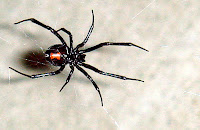God Blessed us with wonderful gifts. Plants & Animals
Genesis 1: 11 ‑ 12
Genesis 1:24
We are blessed but we can't have everything in this world. God gave us a lot of Plants and animals around us which will help us to survive. But do you know that there are certain harmful substances produced by plants and animals?these are called TOXINS.
Toxins are harmful substances from living organisms like plants and animals. Many of them are extremely poisonous. Let us talk about toxins based on what is producing them.Either Plants or Animals.
Plant Toxins
Ricin
- can be extracted from the seeds of Castor Oil plant; a specie of flowering plant in the spurge family, Euphorbiaceae.
- this toxin is highly poisonous whether injected, ingested or even inhaled. It acts as a toxin to the human body by inhibiting protein synthesis, persons exposed to ricin may experience allergic reactions, severe diarrhea and may die of shock.
- just like bacteria and viruses this plant toxin is also a part of the history, In 1978( in London), it was used in the "umbrella murder" where a ricin-treated bullet was used to shoot a Bulgarian defector. The guy died within a day.
Abrin
- a toxin found in the seeds of Lucky bean or Abrus precatorius; its a slender, perennial climber that twines around trees, shrubs, and hedges.
- it acts as toxin by attaching itself to the cell membrane.
- Abrin is far more poisonous than ricin, its fatal dose is 75 times smaller than ricin. 3 micrograms of abrin in the circulation is already lethal.
- But in spite of the poisonous substance abrin found in the lucky bean it still has good uses. The seeds are brightly red in color which makes them beautiful native jewelries (but there should be extra care because there have been cases of death reported due to finger prick while boring the needle to the seed).
- In other places they use the leaves of the lucky bean to treat cough, colds and fever.
Uroshiol- allergen produced by poison ivy.
- it acts as toxin by binding to the skin on contact, where it causes severe itching that develops into reddish coloured inflammation and then blistering.
Animal Toxins
Snake venom- Saliva produced by special glands of snakes.
- The mechanism of action of these venom differ from one another.
Spider Venom- some spiders are venomous and produces neuro toxic venom which attacks the nervous system.
- here are some spiders that possess neurotoxins:
Widow Spider
Australian Funnel Web Spider
Brazilian Wandering Web spider
Scorpion Venom
- Almost all species of scorpions are poisonous to their preys and also to human.
- The venom contains neuro toxins, histamine and other enzymes. Therefore the victim may experience allergic reactions, fever, swelling of the body, agitation or anxiety, pain or tightness in the chest or back.
References:Centers for Disease Control and Prevention
God Blessed us with wonderful gifts. Plants & Animals
Genesis 1: 11 ‑ 12
Then God said, "Let the land produce vegetation: seed‑bearing plants and trees on the land that bear fruit with seed in it, according to their various kinds." And it was so. The land produced vegetation: plants bearing seed according to their kinds and trees bearing fruit with seed in it according to their kinds. And God saw that it was good.
Genesis 1:24
And God said "Let the land produce living creatures according to their kinds: livestock, creatures that move along the ground, and wild animals, each according to its kind." And it was so. God made the wild animals according to their kinds, the livestock according to their kinds, and all the creatures that move along the ground according their kinds. And God saw that it was good.
We are blessed but we can't have everything in this world. God gave us a lot of Plants and animals around us which will help us to survive. But do you know that there are certain harmful substances produced by plants and animals?these are called TOXINS.
Ricin

Abrin

Animal Toxins
Snake venom
- Saliva produced by special glands of snakes.
- The mechanism of action of these venom differ from one another.
Spider Venom
- some spiders are venomous and produces neuro toxic venom which attacks the nervous system.
- here are some spiders that possess neurotoxins:
Widow Spider
Australian Funnel Web Spider
Brazilian Wandering Web spider
Scorpion Venom
- Almost all species of scorpions are poisonous to their preys and also to human.
- The venom contains neuro toxins, histamine and other enzymes. Therefore the victim may experience allergic reactions, fever, swelling of the body, agitation or anxiety, pain or tightness in the chest or back.
References:
Centers for Disease Control and Prevention
USDA Fire Effects Information System
http://library.thinkquest.org




